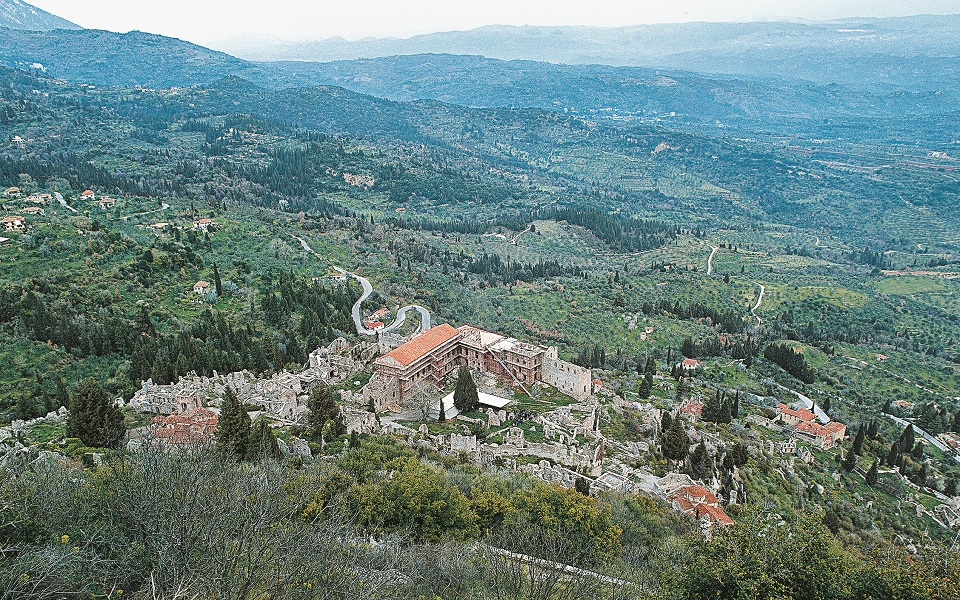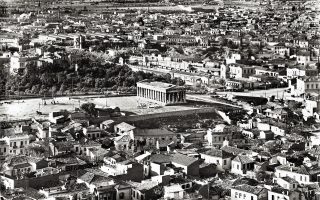Breathing new life into the Castle of Mystras
Professor Stefanos Sinos shares insights on the Byzantine town following publication of his book on the restoration of the Despot’s Palace

It was the Christmas of 1954 when a 17-year-old Stefanos Sinos, accompanied by two of his classmates, visited the Castle of Mystras for the first time. He was already set on becoming an architect and was particularly fascinated by the ancient and medieval monuments of his country. What he saw however inside the archeological site of the fortified late Byzantine town, particularly the Despot’s Palace, left him speechless. “I saw a whole palace, in a condition that seemed to me wild, dangerous,” he said to Kathimerini.
“I did not know who was in charge of the palace’s maintenance,” he continued. “Later on, when I was an academic, I met Anastasios Orlandos, who had overseen the 1937-39 maintenance works, and he explained the way in which they had in fact secured the monument. However, there was a significant amount of weather erosion. In the meantime, I had visited the site numerous times over the years and decided that something had to be done. I thought we could not leave the palace in the state it was.”
Despotate of the Morea
About seven centuries ago – in 1249 and a few decades after the sack of Constantinople by the Crusaders in 1204 – Guillaume II de Villehardouin, the Frankish ruler of the Principality of Achaia, built Mizithra Castle, which took its name from the hill on whose summit it was built. Its purpose was to protect the Eurotas valley from the Slavic Melingoi tribe of Mount Taygetos in Laconia. The Frankish ruler also constructed a building on a lower section of the hill, which he used as a dwelling when visiting the area. However, in 1259, Guillaume was defeated by Michael VIII Palaiologos in the Battle of Pelagonia and in 1262 agreed, among other concessions, to hand over control of the castle.
For the next two centuries, Mystras became the capital of the semi-autonomous Despotate of the Morea, with Manuel Kantakouzenos ruling as the first despot, and would develop into an important economic and cultural center of the late Byzantine Empire. Over the same period, the Despot’s Palace was gradually built around Guillaume’s original dwelling and acquired several new wings, some residential and some serving administrative functions. It reached the height of its grandeur in the early 15th century, an architectural depiction of the efforts of the Palaiologos dynasty to reform the Byzantine Empire. This is when the west wing of the palace was converted into a throne room.
Stefanos Sinos knows about all of that. He had been part of the faculty of the history of architecture department at the Karlsruhe Institute of Technology and by the beginning of the 1980s was a professor of architecture at the National Technical University of Athens. It was at this point that Sinos was informed by George Mylonas, general secretary of the Archeological Society of Athens, that Mylonas had been approached by Konstantinos Karamanlis, then president of the Hellenic Republic, who wished to support the restoration of a Byzantine monument in southern Greece, to complement the excavations of Manolis Andronikos in Macedonia.
Sinos presented his views on the restoration of the Mystras monuments to Mylonas and Karamanlis and, in 1984, a meeting was arranged with Minister of Culture Melina Mercouri. They all agreed that the project should go ahead. The relevant working group was put together that very year and, apart from the initial planning, it quickly organized a large international conference that took place in Mystras.
The restoration works would naturally take many years, with the majority taking place from 1990 to 2015, with Sinos presiding over the scientific restoration committee which had replaced the working group. His communications with Karamanlis would continue via mail. “After our meeting, I never saw him again, but every year I used to send him a report on the progress of the restoration,” Sinos remembers. “He always replied, sometimes using humor and usually with one phrase, ‘Congratulations, you are progressing.’”
The book
Kapon Editions recently published “The Late Byzantine Palace of Mystras and its Restoration,” a book that Sinos completed during last year’s lockdown. He chose to write the book in English, to appeal to the wider international academic community. It is a detailed summary of the architectural history of the Byzantine Despot’s Palace, the initial ruin, the studies and restoration work, the techniques that were eventually used, and all this supported and framed by a rich archive of photographs. Certainly, this is largely a scientific publication, but Sinos introduces the basic aspects of the restoration works and shares his initial vision with the same enthusiasm that he felt on that first visit to the monument.
“It is the only Byzantine palace that has survived in its entirety. There is no palace in Constantinople that is in this good a condition, with all three floors intact,” Sinos informed Kathimerini. “The life of an emperor, a despot, becomes not only understood, but accessible to a visitor today. It is an important building for the history of the region. I also wanted to highlight the architectural influences from the West present in the palace. What were they? Gothic art and architecture, and not just in any form, but its Venetian variant. The windows located in the east wing, built by Manuel Kantakouzenos, are remarkably similar to those in Venice studied and written about by the 19th century British art historian John Ruskin. It is no coincidence that Kantakouzenos often traveled to Italy. After Kantakouzenos, the efforts of John VIII Palaiologos to unite the Orthodox and Catholic churches are manifested in the architecture of the later wings of the palace, with the Venetian Gothic style influencing the later windows of the palace. It is something no one had noticed, and I believe I highlighted it enough.”
The Throne Room
Mystras is also remarkable because, apart from the palace itself surviving in its entirety, the Throne Room in the western wing has also survived. And in this room, there is a detail that Sinos finds particularly fascinating. “The emperor was not seated at the end of the room, in its narrower end, as we imagine rulers would be, waiting for their subjects to walk many meters up to them,” he explained. “Quite the contrary, the emperor was seated in the center of the wider end of the room, finding himself right in the middle of any gathering. The other members attending did not stand in front of the emperor but were seated on a bench around him. This is something that indicates something resembling, in a way, a more democratic relationship between the lord and his officials,” he added. These were the aspects of palace life that Sinos wanted to restore and highlight, the motive behind his extensive restoration work. However, there is a question as to the extent to which monuments should be restored. Are the wear and tear seen at Mystras, the weathering caused by time, not part of the monument’s history?
“The passage of time is evident. One can discern what is old and what is new,” replied Sinos. “Apart from that, of course there are limits and in many cases I am against complete restorations. You need some restraint, some judgment when conducting restoration studies. We cannot restore everything to how it was in the past, because if there is not enough evidence, we will face creating something fake. In some monuments however, those that play an important role in our understanding of regional history and where we have enough evidence, we must go a little further.”
In the case of the Castle of Mystras we are talking about a monument that has been designated a UNESCO World Heritage site. The latest efforts on the site (according to a statement by the Culture Ministry last summer) will be completed by 2023 and will provide visitors with a unique experience with, among others, the showcasing of palace life using new technology.
Sinos is afraid that, due to his age, he will never again be able to visit the monument that spoke to him when he was 17 years old. He feels that his restoration project needed some additional work, which he did not have time to do. He feels no bitterness about this and believes the ministry will be able to procure the funds to finish the project.
Over the many years he spent supervising the project, was there any other part of the restoration that he spent a lot of time on? “I am absolutely certain that in the Throne Room there was a ceiling under the wooden roof,” he concludes. “I did not install one, because it would be based on a fantasy, and the existing lattice trusses point to this. We do know, however, based on the writings of Bessarion of Trebizond, that there was a ceiling in the palace of Trebizond, but I could not simply depend on this piece of evidence. It was a question that kept me up at night.”





